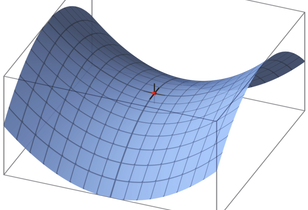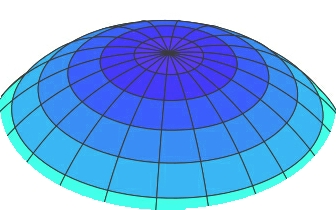Synclastic
Tensile surfaces, that is, surfaces which carry only tension and no compression or bending, rely on double curvature for their stability. Stability is provided by the opposition of two curvatures which enable the surface to be tensioned without losing its form.
Tensioning the surface reduces its elasticity and so its tendency to deform under load, and the curvature itself means that the surface will deform less for any given extension.
Tensile surfaces can be used in buildings to create thin, long span enclosures, such as roofs for sports stadia, shopping centres, atria and so on. Typically they are constructed using a PVC-coated polyester or PTFE coated glass fabric, typically just 1 mm thick.
Double curvature can be anticlastic or synclastic.

|

|
| Anticlastic (saddle-shaped). | Synclastic (dome-shaped) |
Synclastic surfaces are those in which the centres or curvature are on the same side of the surface. This is a dome-shape. This can be created with an architectural fabric by inflation – that is, air pressure within the dome maintains the form of the surface when it is tensioned, rather than the opposition of the curvatures.
This is opposed to anticlastic surfaces, which are those in which the centres of curvature are located on opposing sides of the surface. This is commonly-described as a saddle shape. A hyperbolic paraboloid is an anticlastic surface.
[edit] Find out more
[edit] Related articles on Designing Buildings Wiki
- Anticlastic.
- Barrel vault.
- Biaxial bending.
- Concept structural design of buildings.
- Conoid shell.
- Fabric structures.
- Hyperbolic paraboloid.
- Limit state design.
- Structural engineer.
- Tensegrity.
- Tensile structures.
- The development of structural membranes.
- The structural behaviour of architectural fabric structures.
- Types of dome.
- Why are domes popular?
Featured articles and news
Infrastructure that connect the physical and digital domains.
Harnessing robotics and AI in challenging environments
The key to nuclear decommissioning and fusion engineering.
BSRIA announces Lisa Ashworth as new CEO
Tasked with furthering BSRIA’s impressive growth ambitions.
Public buildings get half a million energy efficiency boost
£557 million to switch to cleaner heating and save on energy.
CIOB launches pre-election manifesto
Outlining potential future policies for the next government.
Grenfell Tower Inquiry announcement
Phase 2 hearings come to a close and the final report due in September.
Progress from Parts L, F and O: A whitepaper, one year on.
A replicated study to understand the opinion of practitioners.
ECA announces new president 2024
Electrical engineer and business leader Stuart Smith.
A distinct type of countryside that should be celebrated.
Should Part O be extended to existing buildings?
EAC brands heatwave adaptation a missed opportunity.
Definition of Statutory in workplace and facilities management
Established by IWFM, BESA, CIBSE and BSRIA.
Tackling the transition from traditional heating systems
59% lack the necessary information and confidence to switch.
The general election and the construction industry
As PM, Rishi Sunak announces July 4 date for an election.
Eco apprenticeships continue help grow green workforce
A year after being recognised at the King's coronation.
Permitted development rights for agricultural buildings
The changes coming into effect as of May 21, 2024.





















